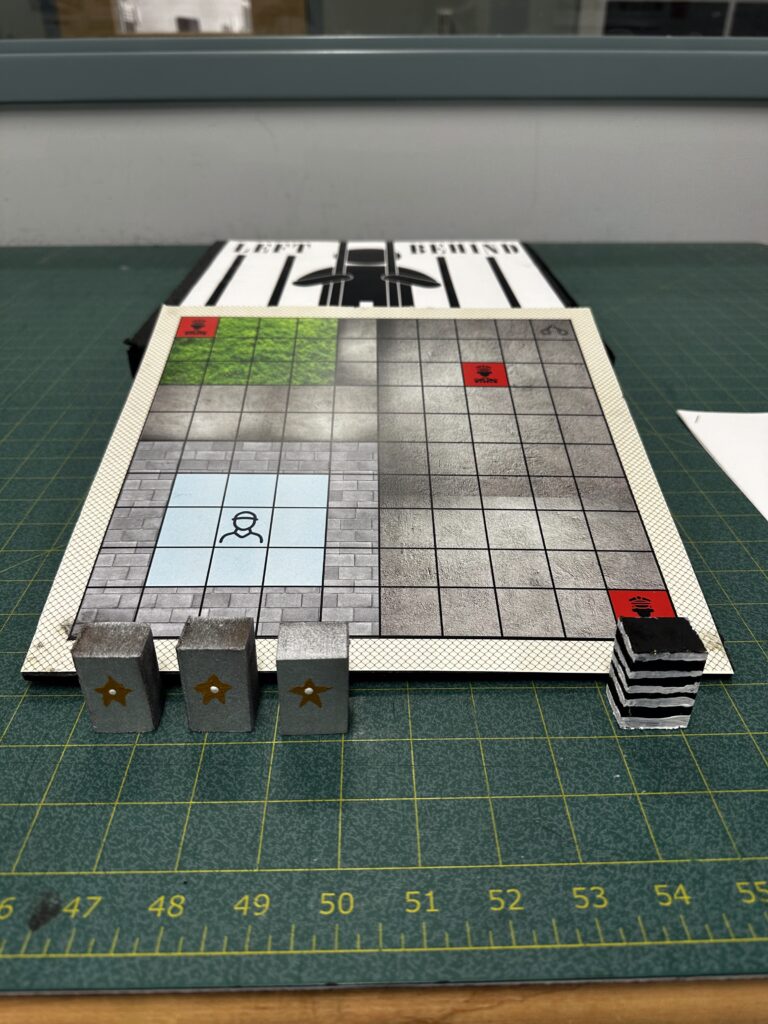Left Behind

Setup:
Pieces included: 1x Prisoner 3x Guards 1x Board
To set up the board, begin by placing the BLACK prisoner piece in the middle of the light blue 3×3 grid, that is where the prisoner will begin the game. Place the 3 guard pieces in the 3 red squares around the board. Before the game starts, players must decide which pieces they will be and can be decided amongst themselves, or with a single die.
Locations:
The light blue area is where the prisoner spawns into the game, guards may not enter the light blue area. The prisoner, though, is allowed to move one space diagonally rather than vertically and horizontally in the light blue area if he chooses to do so.
The grass area (courtyard) is a special area that can help the prisoner. Since this is an outside area, the prisoner may move one extra space if he chooses to do so. The guards cannot move any extra spaces inside of the courtyard and they continue to move normally.
Playing the game:
Once the pieces are on the board, the prisoner will go first by moving either 1 or 2 spaces in any direction other than diagonal. The prisoner may only move in one direction though (EX: If you are moving right on the board 1 space, your second space must also be in that direction.
Once the prisoner has moved, each guard takes their turn moving 1 space in any direction (INCLUDING DIAGONAL).
Goal: The goal is for the guards to intercept the prisoner before he leaves the prison on the top right of the board. Once the prisoner gets to the handcuff space, the prisoner wins the game and the guards lose (unless “No Man Left Behind” is called). If the guards get to the prisoner before he escapes, the guards win the game.
The game will be played best 2 out of 3 rounds (or however many sequential rounds you would like to play). If the prisoner makes it to the exit space before the guards and he believes he can make it back to the starting space before the guards catch him, he may return to the starting place for a chance to win the entire game. This must be stated by calling out “No Man Left Behind”.
For the sake of the game not being impossible (which the point of the game is to make it extremely hard for the prisoner), guards may not enter the three surrounding spaces next to the handcuff space.
Rock N Roll Em



Rules:
Each player will take turns going in a circle asking the group a Rock N’ Roll related question on the cards.
Players may decide who goes first, as it does not have an effect on game play.
Once a player asks the question, a 30 second timer will be set for the group to answer the question. If time runs out, the card will reward no points to anyone.
If a player answers correctly, they will keep the card until the end of the round which will determine how many points they have.
The player with the most cards at the end of the round, will win.
If a player answers a question wrong, another player can take the opportunity to steal the question for themselves. (Timer does not reset). If they do this and get it right, the player gets to take a card from their opponent. But if they attempt to steal and they get it wrong, the next player to steal the same question gets cards from both players who attempted to answer it. (This can stack to as many players that attempt to answer).
Crackin’ Jokes
What was the most frustrating moment or aspect of what you just played?
I honestly didn’t get frustrated playing this game, since it’s Evans.
What was your favorite moment or aspect of what you just played?
I enjoyed cracking the glow sticks and listening to what people came up with.
Was there anything you wanted to do that you couldn’t?
I wanted some jokes to be something where the whole group had to tell a joke.
If you had a magic wand to wave, and you could change, add, or remove anything from the experience, what would it be?
N/A
What should be improved with the next version?
Lightsabers instead of glowsticks, hope Evan sees this one.
What was the games message?
All about having a good time and cracking jokes with your friends.
Around The World
What was the most frustrating moment or aspect of what you just played?
It makes it hard playing with a larger number of people due to play speed.
What was your favorite moment or aspect of what you just played?
Group participation cards made the game fun when everyone was doing something together.
Was there anything you wanted to do that you couldn’t?
N/A
If you had a magic wand to wave, and you could change, add, or remove anything from the experience, what would it be?
More lively design.
What should be improved with the next version?
I think that there should be less blank spaces, a few are fine but the less the better.
What was the games message?
Learning geography instead of in High School.
Hues and Cues
What was the most frustrating aspect?
Good luck if you are colorblind…
Favorite Moment of the game?
The description of colors, can definitely be creative with this one.
Was there anything I wanted to do and couldn’t?
N/A
If I had a magic wand to change, add, or remove anything?
N/A
Improved for next version?
I think the overall design can be improved on, but other than that it’s a great game.
Games message?
Guerilla paint marketing
Game in 3 words?
Artsy, engaging, group fun
Barrel of Truth
What was the most frustrating moment or aspect of what you just played?
When the prompt isn’t as funny as others, but it’s part of the game.
Favorite Part of the game:
Some answers are very unexpected, which makes the game fun.
Magical Whimsical Change:
N/A
Suggestions:
Special rounds to add a little more to the game, pretty simple as is.
Message:
Be expecting real honesty
3 Words:
Funny, social, Mind free
Dyl’s Game
What was the most frustrating moment or aspect of what you just played?
The most frustrating part was my starting hand.
What was your favorite moment or aspect of what you just played?
My favorite part was when the game switches up really quick, makes it unpredictable.
Was there anything you wanted to do that you couldn’t?
No
If you had a magic wand to wave, and could change, add, or remove anything from the experience, what would it be?
I can’t really think of many things to add to the current game, feels right the way it is played.
What should be improved with the next version?
More characters.
Describe the game in 3 words.
Fun, Competitive, Quick
Week 7 Response
- Read:
- Brian Winn, Carrie Heeter, “Resolving Conflicts in Educational Game Design through Playtesting“ Innovate: Journal of Online Education Volume 3, Number 2, December 2006
- What are the challenges a team faces when working on an educational game?
Balancing the content with being fun but also educational, differing team goals, and the occasional communication errors with your team.
- In the case study team members vetoed each others game ideas, what were the scientist’s, pedagogy expert’s and designer’s issues?
Concerns over scientific accuracy, concerns with educational effectiveness, and the enjoyment of the game.
- What did the team learn from play testing their prototypes?
They identified the issues of the game, gained insight on player engagement, and definitely improved game mechanics.
- How does play testing resolve conflicts among team members?
It can provide objective feedback, helps the team align their goals, and it helps to reduce misunderstandings by showing what is and isn’t working.
Gone Fishin’

Gone Fishin’ Rules
Setup:
Each player selects their choice of rod and players collectively agree which location they want to fish at (Each Location has different types of fish to catch). Shuffle the deck of fish cards and place 5 at each “honey hole” on the map.
Game Play:
To start the game, roll a 6 sided die in order to determine the order of play. Each player will roll their dice and if they roll the correct numbers corresponding to their rod, they get a chance to pick a fish from the “honey hole” they choose. You must pick which honey hole you want to fish from before rolling your dice. Some cards have no fish on them and you may catch a “junk” item which does nothing.
If you catch a fish you get to put it in your cooler. You may only have three fish in your cooler at a time. If you want to continue fishing once you have 3 fish in your cooler, you must release a fish back into the wild (discard pile). This must be done strategically since you may release a fish and catch a worse one.
Winning The Game:
The way you win the game is by catching the biggest fish for that type of species.
EXAMPLE: You have the largest crappie and bass of all the players, so you get 2 points.
The player with the most amount of biggest fish wins, so it is important to try and catch multiple big fish and not just a singular one.
Simulation Games
Fishing Simulator: In this game, you are required to catch the biggest fish in order to receive points. Each player has a different rod with different ways to catch fish. After a few rounds, the player with the biggest fish wins.
Tax Fraud Simulator: In this “game”, there is a mock tax form that you must fill out. The opposing player (government), must find which items are incorrect on the form and have been lied about. Players alternate turns until one player can get away scot-free 3 times.
Time Travel Simulator: Players operate a time travel agency, sending agents to different eras to complete missions like retrieving artifacts or preventing disasters. The board is a timeline, and actions in one era ripple forward, altering future events or resources. Random “paradox” cards add chaos, forcing players to adapt. The goal is to earn the most tokens (completing challenges) by mission end.
Martian Simulator: Players are crew members of a colony on mars, simulating life in a harsh extraterrestrial environment. The board represents the colony, with areas for farming, mining, and research. Players roll dice to determine resources and face challenges like solar flares or alien wildlife. Cooperation is pretty important, but a traitor mechanic adds tension. Winning comes from surviving a set number of days with a self-sustaining base.
City Sim: An urban planning simulation where players compete to build the best city. Each player manages a grid-based city, allocating funds to infrastructure and public services. Weather events and population challenge players to adapt. Points are scored based on citizen happiness.
Maize Runner Game
Rules:
Each player will start in a different quadrant, signified by the openings on the end of the maze.
Players will roll to see who goes first, highest number goes first, second highest goes second, etc.
Players will roll a single dice to determine how many spaces they move.
If a player rolls a 6, they get to place a wall piece to block off another players path.
If a player lands on a green dot space, you get a card to remove a wall that can be used once.
First person to the end of the maze wins the game, game can continue for 2nd, 3rd, and 4th.

Game Ideas: Week 4
- RGB: A game where players race to create a specific color pattern using colored tiles. Each player has a small board and a deck of color cards, each showing a different pattern. The goal is to match the pattern shown on the card using the tiles, but the tiles are drawn randomly.
- Maize: Players try to escape from a maze before the other players, but they can only move based on a limited number of dice rolls that tell them how far they can move and in what direction. If a 1 is rolled, the player doesn’t move but gets to draw a card for certain items that can be used in game.
- Stack’d: A competitive stacking game where players must stack objects based on a random card. The challenge could be stacking in specific patterns, building the tallest tower, or balancing objects.
Week 3 Game Ideas
- Players take on the roles of characters who are experiencing challenges outside their usual reality. Each level is a different scenario where the player must complete tasks while dealing with the limitations of their character’s situation. The objective is to navigate the world and its challenges by understanding and overcoming barriers that others face every day.
- This narrative-driven game lets players experience stories of various characters from different backgrounds. Each character has a backstory, and players interact with them to build relationships, solving puzzles or helping them through life challenges. Players must learn to listen and respond, using dialog choices that reflect understanding and compassion.
- Players are tasked with conflicts between two groups or individuals who have opposing beliefs. They must facilitate understanding, find common ground, and propose solutions that benefit both sides. Success in the game depends on the player’s ability to listen to both sides.
- In this puzzle game, players connect pieces of a heart-shaped puzzle by guiding the emotions of characters. Each piece of the heart represents a different character’s journey, and players must work through these emotions to heal relationships. Players must navigate through obstacles, building empathy by learning the motivations, fears, and desires of the characters they encounter.
- Players experience the same events from the perspective of multiple people, where each character is affected by the situation in different ways. For example, during a natural disaster, players might experience it as a rescuer, a survivor, and a displaced family member. The game asks players to switch between perspectives and understand how individuals perceive the same event differently, teaching players to view the world through others’ eyes and make decisions that consider multiple viewpoints.
Week 3 Questions
- how does mary flanagan’s definition of game differ from chris crawford’s as well as the definition crafted by katie salen and eric zimmerman?
Flanagan emphasizes that games can be seen as a form of cultural expression, while Crawford sees games as systems of interaction, focusing on the idea that games are interactive stories. Salen and Zimmerman define games more formally as structured activities
- what is an activist game?
An activist game is a game designed with the intention of making a political, social, or cultural statement.
- go and chess are examples of games that feature “perfect information”, what other games share that feature?
Checkers, Tic tac toe, connect four
- why might chance or gambling games hold spiritual or religious importance to ancient cultures?
Chance or gambling games may have held spiritual or religious significance because they represent the unpredictability of life or the will of the gods.
- when was the earliest battle between government/ religious groups and games? what modern games can you think of that have been banned or demonized?
One of the earliest recorded battles over games can be traced back to ancient Rome, where authorities sought to limit or ban games of chance like dice. In more recent years, D&D has been demonized.
- what is a fox game, and what would be a modern example?
A fox game refers to a game that involves trickery, manipulation, or misdirection. A modern example would be Mafia.
- what was the purpose or intent of the game: Mansion of Happiness?
Mansion of Happiness was a board game that was designed to teach children about virtue and the consequences of their actions.
- Why do artists from the Fluxus and Surealist movements play games? Why did Surealists believe games might help everyone?
Fluxus artists were interested in the breakdown of traditional art forms and the idea of making art part of everyday life, while Surealists believed that games could reveal the unconscious mind and inspire creativity.
- Changes in what can signal profound changes in games?
Changes in the social, cultural, or political environment can signal changes in the design and purpose of games.
- What statements did Fluxus artists make by reskinning games like monopoly and ping pong?
By reskinning games like Monopoly and Ping Pong, Fluxus artists were challenging the commercialization of play.
- How are artists like Lilian Ball, Marcel Duchamp, Takako Saito, Yoko Ono, Gabriel Orozco and Ruth Catlowusing war games?
These artists have engaged with war games as a means of avoiding traditional understandings of conflict and violence.
- Why is it important for players to have agency in a critical or serious game?
Agency in serious games is important because it allows players to feel that their actions have consequences.
